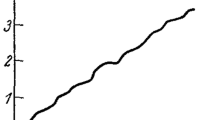Abstract
In order to describe rigorously certain measurement procedures, where observations of the arrival of quanta at a counter are made throughout an interval of time, it is necessary to introduce the concept of a quantum stochastic process. While fully quantum mechanical in nature, these have a great deal of similarity with classical stochastic processes and can be characterized by and constructed from their infinitesimal generators. The infinitestimal generators are naturally obtained from certain “fields” which we prove must be of the boson or fermion type.
Similar content being viewed by others
References
Glauber, R. J.: Photon statistics; Fundamental problems in statistical mechanics II, ed. by E. G. D. Cohen. Amsterdam: North-Holland Publishing Company 1968.
Klauder, J. R., and E. C. G. Sudarshan: Fundamentals of quantum optics. New York: W. A. Benjamin Inc. 1968.
Glauber, R. J.: Quantum theory of optical coherence. Phys. Rev.130, 2529–2539 (1963).
Davies, E. B., and J. T. Lewis: An operational approach to quantum probability. To appear.
Davies, E. B.: Systems of imprimitivity. To appear.
-- On the repeated measurement of continuous observables in quantum mechanics. To appear.
Feller, W.: An introduction to probability theory and its applications, Vol. 2. New York: Wiley 1966.
Mackey, G. W.: Unitary representations of group extensions. Acta Math.99, 265–311 (1958).
Namioka, I.: Partially ordered linear topological spaces. Mem. Am. Math. Soc.24 (1957).
Stormer, E.: Positive linear maps of operator algebras. Acta Math.110, 233–278 (1963).
Hille, E., and R. S. Phillips: Functional analysis and semigroups. Coll. Publ. Am. Math. Soc. (1957).
Yoshida, K.: Functional analysis. Berlin-Heidelberg-New York: Springer 1965.
Dixmier, J.: Dual et quasi-dual d'une algèbre de Banach involutive. Trans. Am. Math. Soc.104, 278–283, (1962).
Mackey, G. W.: Borel structure in groups and their duals. Trans. Am. Math. Soc.85, 134–165 (1957).
Iwasawa, K.: On some types of topological groups. Ann. Math.50, 507–558 (1949).
Bargmann, V.: On unitary ray representations of continuous groups. Ann. Math.59, 1–46 (1954).
Halmos, P. R.: Measure theory. New York: D. van Nostrand 1950.
Lumer, G., and R. S. Phillips: Dissipative operators in a Banach space. Pacific J. Math.11, 679–698 (1961).
Segal, I. E.: Tensor algebras over Hilbert spaces II. Ann. Math.63, 160–175 (1956).
—— Tensor algebras over Hilbert spaces I. Trans. Am. Math. Soc.81, 106–134 (1956).
Author information
Authors and Affiliations
Additional information
This work was supported by a National Science Foundation grant GP-7952X.
Rights and permissions
About this article
Cite this article
Davies, E.B. Quantum stochastic processes. Commun.Math. Phys. 15, 277–304 (1969). https://doi.org/10.1007/BF01645529
Received:
Issue Date:
DOI: https://doi.org/10.1007/BF01645529




